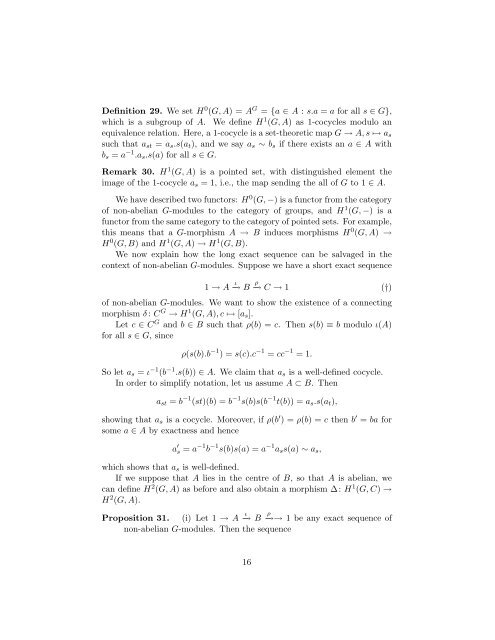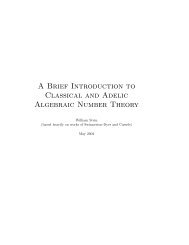A Short Course on Galois Cohomology - William Stein - University of ...
A Short Course on Galois Cohomology - William Stein - University of ...
A Short Course on Galois Cohomology - William Stein - University of ...
You also want an ePaper? Increase the reach of your titles
YUMPU automatically turns print PDFs into web optimized ePapers that Google loves.
Definiti<strong>on</strong> 29. We set H 0 (G, A) = A G = {a ∈ A : s.a = a for all s ∈ G},<br />
which is a subgroup <strong>of</strong> A. We define H 1 (G, A) as 1-cocycles modulo an<br />
equivalence relati<strong>on</strong>. Here, a 1-cocycle is a set-theoretic map G → A, s ↦→ as<br />
such that ast = as.s(at), and we say as ∼ bs if there exists an a ∈ A with<br />
bs = a −1 .as.s(a) for all s ∈ G.<br />
Remark 30. H 1 (G, A) is a pointed set, with distinguished element the<br />
image <strong>of</strong> the 1-cocycle as = 1, i.e., the map sending the all <strong>of</strong> G to 1 ∈ A.<br />
We have described two functors: H 0 (G, −) is a functor from the category<br />
<strong>of</strong> n<strong>on</strong>-abelian G-modules to the category <strong>of</strong> groups, and H 1 (G, −) is a<br />
functor from the same category to the category <strong>of</strong> pointed sets. For example,<br />
this means that a G-morphism A → B induces morphisms H 0 (G, A) →<br />
H 0 (G, B) and H 1 (G, A) → H 1 (G, B).<br />
We now explain how the l<strong>on</strong>g exact sequence can be salvaged in the<br />
c<strong>on</strong>text <strong>of</strong> n<strong>on</strong>-abelian G-modules. Suppose we have a short exact sequence<br />
1 → A ι −→ B ρ −→ C → 1 (†)<br />
<strong>of</strong> n<strong>on</strong>-abelian G-modules. We want to show the existence <strong>of</strong> a c<strong>on</strong>necting<br />
morphism δ : C G → H 1 (G, A), c ↦→ [as].<br />
Let c ∈ C G and b ∈ B such that ρ(b) = c. Then s(b) ≡ b modulo ι(A)<br />
for all s ∈ G, since<br />
ρ(s(b).b −1 ) = s(c).c −1 = cc −1 = 1.<br />
So let as = ι −1 (b −1 .s(b)) ∈ A. We claim that as is a well-defined cocycle.<br />
In order to simplify notati<strong>on</strong>, let us assume A ⊂ B. Then<br />
ast = b −1 (st)(b) = b −1 s(b)s(b −1 t(b)) = as.s(at),<br />
showing that as is a cocycle. Moreover, if ρ(b ′ ) = ρ(b) = c then b ′ = ba for<br />
some a ∈ A by exactness and hence<br />
a ′ s = a −1 b −1 s(b)s(a) = a −1 ass(a) ∼ as,<br />
which shows that as is well-defined.<br />
If we suppose that A lies in the centre <strong>of</strong> B, so that A is abelian, we<br />
can define H 2 (G, A) as before and also obtain a morphism ∆: H 1 (G, C) →<br />
H 2 (G, A).<br />
Propositi<strong>on</strong> 31. (i) Let 1 → A ι −→ B ρ −→→ 1 be any exact sequence <strong>of</strong><br />
n<strong>on</strong>-abelian G-modules. Then the sequence<br />
16
















